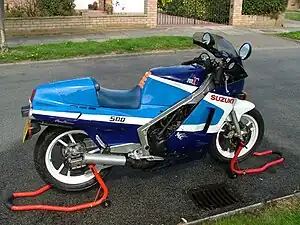Suzuki RG500
The Suzuki RG500 "Gamma", a sport bike with a two-stroke engine, was produced by Suzuki for just two years between 1985 and 1987.
 | |
| Manufacturer | Suzuki |
|---|---|
| Production | 1985–1987 |
| Class | Sport bike |
| Engine | 498.5 cc (30.42 cu in) two-stroke, four-cylinder U engine, liquid-cooled |
| Bore / stroke | 56 mm × 50.6 mm (2.20 in × 1.99 in) |
| Compression ratio | 7.0:1 |
| Ignition type | CDI |
| Transmission | Cassette-type 6-speed constant mesh manual, chain final drive |
| Frame type | Box-section aluminum, double cradle |
| Suspension | Front: 38 mm telescopic fork with hydraulic anti-dive Rear: full-floater swing arm |
| Brakes | Front: dual 260 mm discs with four-piston calipers Rear: 210 mm disc with twin-piston caliper |
| Tires | Front: 110/90-16 rear: 120/90-17 |
| Wheelbase | 1,425 mm (56.1 in) |
| Dimensions | L: 2,100 mm (83 in) W: 695 mm (27.4 in) H: 1,185 mm (46.7 in) |
| Seat height | 770 mm (30 in) |
| Fuel capacity | 22 L (4.8 imp gal; 5.8 US gal) |
The RG "Gamma" 500 was directly based on the series of Suzuki RG Γ 500 Grand Prix motorcycles with almost identical features to the official two-stroke machines used by Italian world champion Franco Uncini during the 1984 season with the Gallina team. The RG Γ 500 won two consecutive Riders' Championships in the 500 cc class with Marco Lucchinelli in 1981 and Franco Uncini in 1982. Like its GP forebears, the road-going RG was powered by a naturally aspirated, rotary-valve inducted, twin crank square four two-stroke engine displacing some 498 cc. This engine employed thermostatically controlled liquid-cooling by means of a front-mounted radiator.
Suzuki used an aluminum box-section frame with castings for the headstock and rear swing arm. The front suspension had pre-load adjust, as well as an anti-dive system called Posi Damp. This was a popular feature on early 1980s sports bikes and was supposed to control the tendency of a motorcycle's nose to dive under braking. At the rear, the full-floater suspension design used dual swing arms.
RG400
A smaller 397 cc derivative, known as the RG400, was also developed and produced alongside the 500. This machine appeared identical to its bigger brother in every way, making use of the same frame, suspension, and gearbox. However, the main differences between the two were a reduced bore width (50mm instead of 56mm) with power output reduced to 59 bhp (44 kW), different big end roller bearings (some roller-less), clutch disks unit, front brakes (non floating discs), silencers, and 'RG400' stickers on the fairings.
The RG400 was produced and sold within Asian markets: its 397cc capacity and 59 bhp (44 kW) output complied with a restricted Japanese motorcycle driving licence of the time.
Production numbers
| Model | 1985 | 1986 | 1987 | Total |
|---|---|---|---|---|
| RG500 | 7340 | 1412 | 532 | 9284 |
| RG400 | 5002 | 863 | 348 | 6213 |
References
- Ash, Kevin (September 19, 2008), "Classic bikes: Blast from the past; We found out how it feels to ride a faithful replica of Mike Hailwood's 1967 Honda 500 four and a Suzuki RG500", The Daily Telegraph, retrieved 2012-06-04
- Cameron, Kevin (2009), "April 1983 Chassis and Suspension, Part 2", Top Dead Center 2:Racing and Wrenching With Cycle World's Kevin Cameron, MBI Publishing Company, pp. 99–113, ISBN 9780760336083, retrieved 2012-06-04
- Cameron, Kevin (2009), "July 1985; Buell: The Other American Maker", Top Dead Center 2:Racing and Wrenching With Cycle World's Kevin Cameron, MBI Publishing Company, pp. 200–211, ISBN 9780760336083, retrieved 2012-06-04
- Snowsill, Paul (April 16, 2007), "A bit of RG bargy", Motor Cycle News, retrieved 2012-06-04
- Walker, Mick (2002), Mick Walker's Japanese Grand Prix Racing Motorcycles, Redline Books, pp. 132–135, ISBN 9780953131181, retrieved 2012-06-04